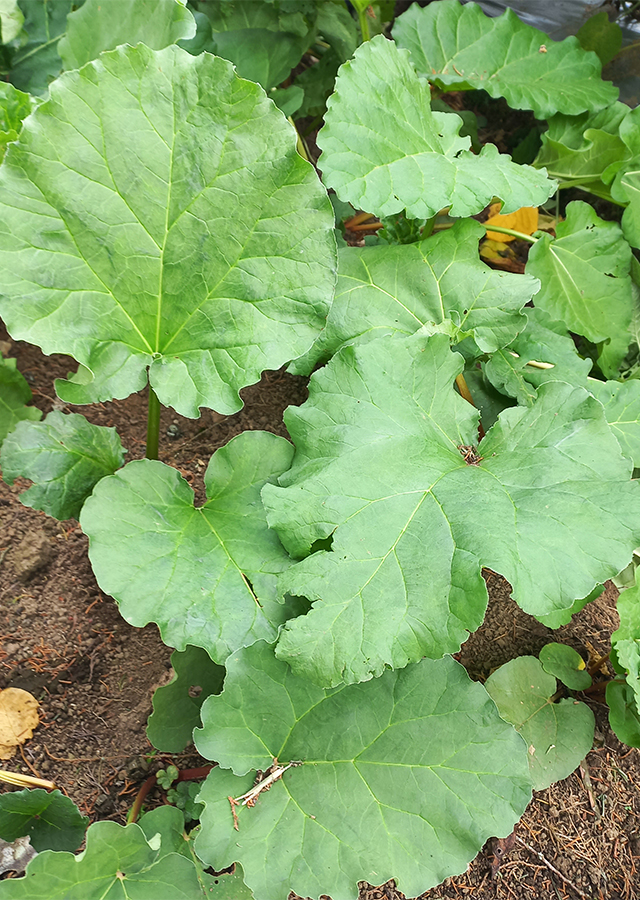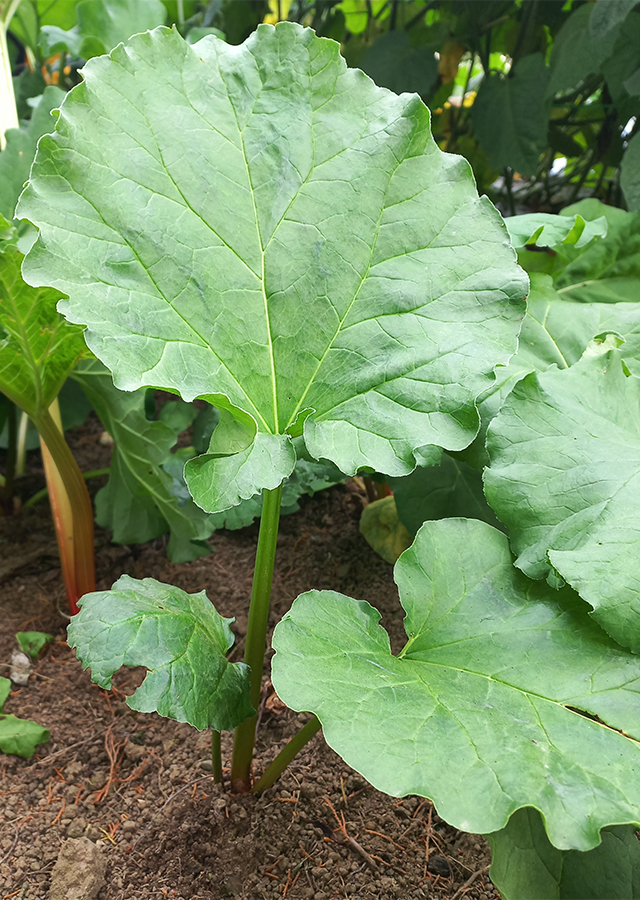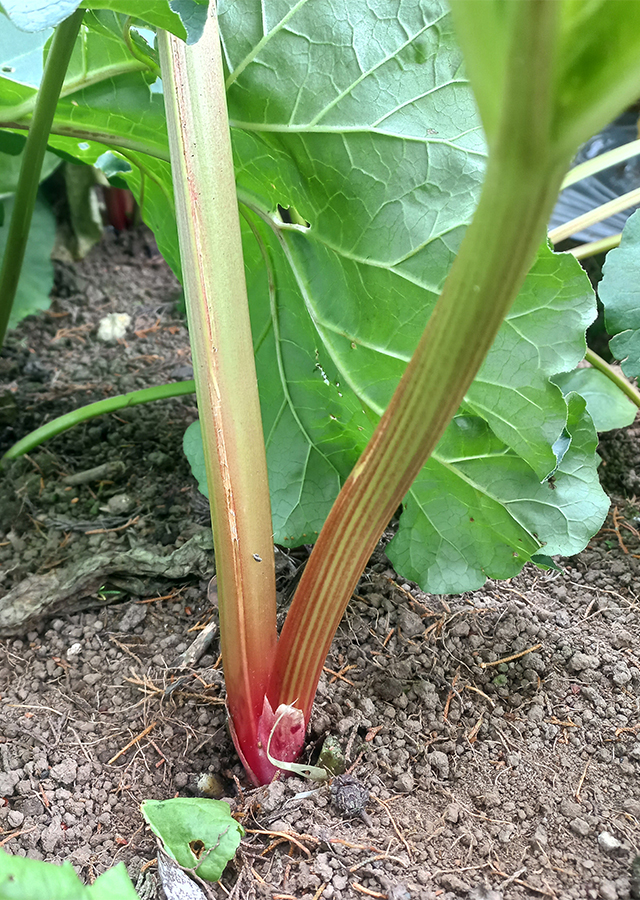Garden Rhubarb
Rheum rhabarbarum L.
Polygonaceae
Location in our garden
Vegetable



Synonym
Rhabarbarum verum Garsault
Rheum muricatum Blanco
Rheum undulatum L.
Habitus
Herbaceous. Herbs, perennial, growing in height ranging from 60 - 90 cm
Part Used
Roots
Stem
Growing Requirements
Full Sunshine
Need Shade
Low Temperature
Habitat
Mountains
Roadside
Grassland
Terrestrial
Overview
Rhubarb is a species of the family Polygonaceae, which is native to Siberia. For more than 5000 years, Rhubarb is used as a medicinal plant in Asia. Rhubarb has a long history, in its use as a traditional medicine by the Chinese, Arabs, and Greeks since thousands of years ago, which is believed to be able to overcome various diseases. Rhubarb is also a well-known vegetable in Asia but was not widely grown in the past. In the 1700s, introduced by European settlers it was mostly known as the pie plant. Rhubarb is one of the vegetables low in calories, high in antioxidants, rich in vitamins A, C, K, and contains minerals (iron, copper, potassium, calcium) and dietary fiber that provide many good health benefits. The parts of the rhubarb plant that are widely used are the stems and roots, but not the leaves. This is because rhubarb leaves contain very high oxalic acid compounds, which can have no effect if they enter the body. Rhubarb stalks can be consumed in various ways, either raw, mixed into smoothies, processed into jams, pies, ice cream, mixed juices or kombucha, or compotes. In addition, rhubarb can also be grown into a beautiful ornamental plant with its large, textured leaves and gnarled stems.
Vernacular Names
Rhabarber (German), Rabarber (Dutch), Rhubarbe (French), Rabarbaro (Italian).
Agroecology
Rhubarb is a herbaceous plant that grows in anthropogenic habitats (artificial or disturbed habitats), grasslands, and fields. This species grows well in cold climates, in soils that are high in organic matter, moist (consistent), well drained, with a slightly acidic to neutral soil pH. The growth prefers a position in full sun, which means at least six hours of direct sunlight most days. However, plants in warmer growth zones usually benefit from late afternoon shade, especially during the hottest months of the year. Too much shade can result in thin stems. Rhubarbs like climates where the average temperature is below 40 °F in winter and below 75 °F in summer. Growing rhubarb likes consistent moisture, but as it matures it is somewhat drought tolerant. In the first two years of growth, this species requires regular watering.
Morphology
- Stems - fleshy, juicy, has a sour taste. Stems are red, pink or light green.
- Leaves - arranged scattered (alternate), heart-shaped or sagittate (arrow-shaped with pointed lobes facing back), wavy leaf edges (no teeth or lobes), dark green with a diameter of 30 cm. Long, thin petioles resembling celery, dark red to light green.
- Flowers - hermaphrodite, the petals are green-brown, white to rose-red. The petals and sepals are separate and not fused. Sepals resemble petals in color and texture. Stamens numbered 9, anthers (anthers) have narrow slits or grooves that extend along the anthers, have two or more separate pistil stalks (style).
- Fruits - achene (dried but not cracked when ripe, usually one-seeded), has one or more wings on top.
Cultivation
Propagation by seeds and division. However, propagation is best done by division rather than from seed. This is because propagation from seeds takes a long time and sometimes seeds are difficult to find.
Chemical Constituents
Lutein, lycopene, zeaxanthin, anthocyanins, proanthocyanidins, beta carotene, polyphenolic compounds, tannins, anthraquinones, hydroxyanthraquinones, aloe-emodin, emodin, rhein, stilbene, rhaponticin.
Traditional Medicinal Uses
- Maintain heart health, bone health, blood pressure, eye health, the health of cardiovascular organs, especially the kidneys.
- Treat constipation.
- Prevent Alzheimer's, cancer, calcification of blood vessels.
- Help lose weight, lower cholesterol.
- Improve blood circulation.
- Reduce inflammation.
- Increase body immunity.
- Prevent and treat canker sores.
- Has antioxidant, antibacterial, antimicrobial, and anti-inflammatory activity.
Part Used
Reference Sources
- Royal Botanic Gardens, Kew. Plats of the World Online: Rheum rhabarbarum L.. https://powo.science.kew.org/taxon/urn:lsid:ipni.org:names:301818-2. 24-07-22.
- Healthbenefitstimes. 2021. Top 11 benefits of Rhubarb (Garden rhubarb). https://www.healthbenefitstimes.com/rhubarb/. 24-07-22.
- WebMD. 2022. Health Benefits of Rhubarb. https://www.webmd.com/diet/health-benefits-rhubarb. 24-07-22.
- Native Plant Trust. Rheum rhabarbarum — garden rhubarb. https://gobotany.nativeplanttrust.org/species/rheum/rhabarbarum/. 24-07-22.
- The Spruce. 2022. How to Grow and Care for Rhubarb. https://www.thespruce.com/growing-rhubarb-1403450. 24-07-22.

